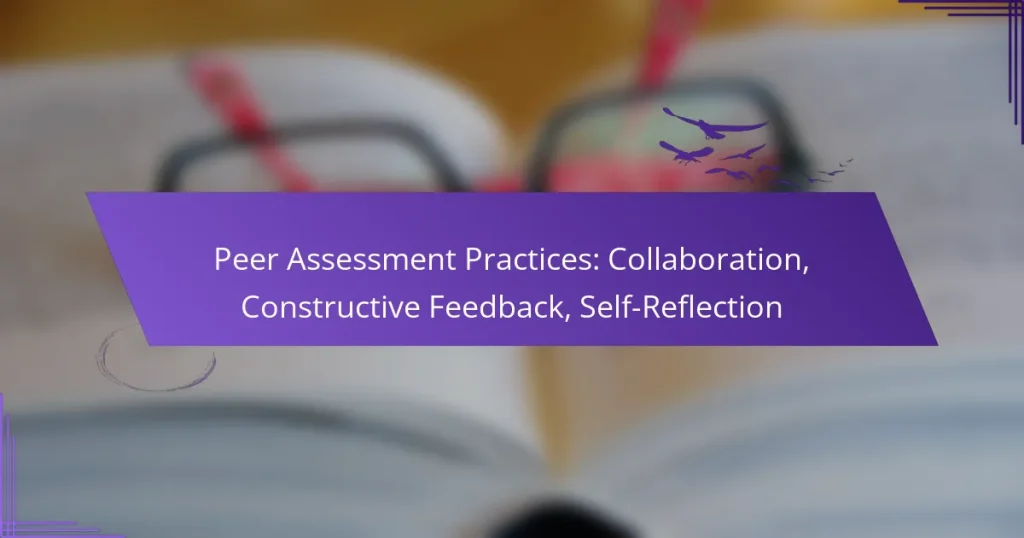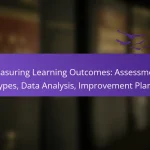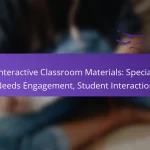Peer assessment practices play a crucial role in enhancing collaboration and fostering a supportive learning environment among students. By engaging in constructive feedback and self-reflection, learners not only improve their understanding of the material but also build meaningful connections with their peers. This dynamic process encourages a growth mindset, ultimately leading to a more enriched educational experience.
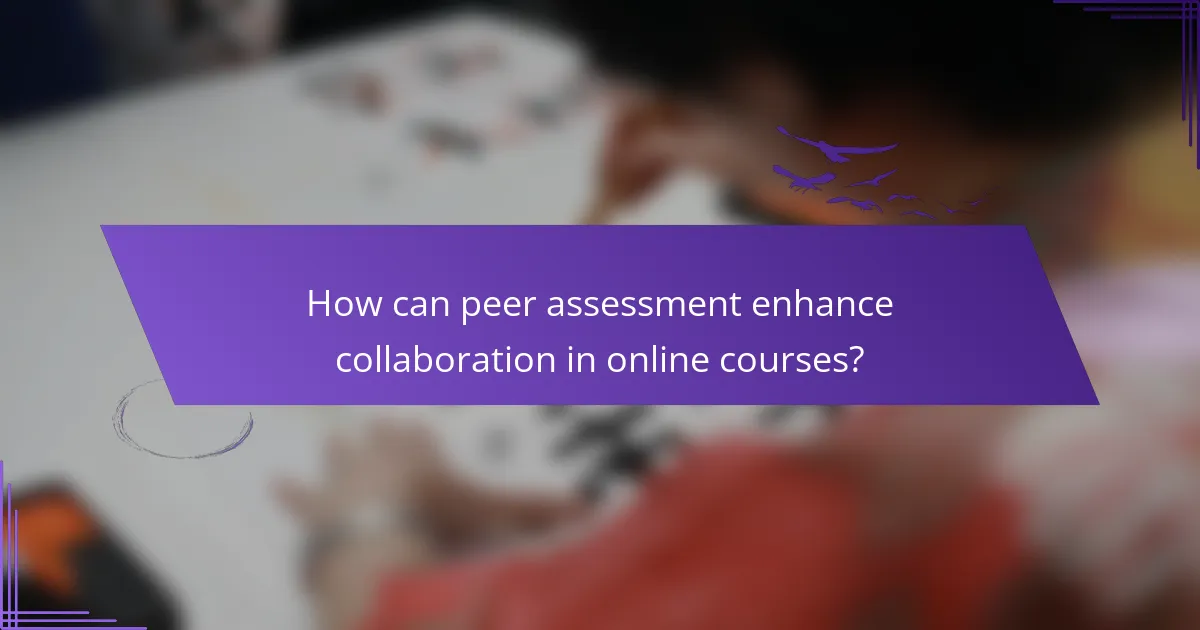
How can peer assessment enhance collaboration in online courses?
Peer assessment enhances collaboration in online courses by promoting interaction among students, fostering a shared learning environment, and encouraging collective problem-solving. This practice allows learners to engage with each other’s work, providing constructive feedback that deepens understanding and strengthens relationships.
Facilitates group discussions
Peer assessment encourages students to engage in group discussions, where they can share insights and clarify concepts. These discussions often lead to richer dialogues, as learners articulate their thoughts and respond to differing viewpoints. Facilitating regular check-ins or discussion forums can help maintain momentum and ensure everyone participates.
Encourages diverse perspectives
When students assess each other’s work, they are exposed to a variety of viewpoints and approaches. This exposure broadens their understanding and encourages critical thinking. To maximize this benefit, instructors can assign diverse groups or use structured peer review guidelines that prompt students to consider alternative perspectives.
Builds a sense of community
Peer assessment fosters a sense of belonging among students, as they collaborate and support one another’s learning journeys. By creating opportunities for students to interact, such as through peer review sessions or group projects, instructors can help cultivate a supportive online community. Recognizing contributions publicly can further enhance this sense of community.
Improves teamwork skills
Participating in peer assessment helps students develop essential teamwork skills, such as communication, negotiation, and conflict resolution. These skills are vital in both academic and professional settings. Instructors can incorporate team-based assessments that require students to work together, providing a practical context for honing these abilities.
Increases engagement
Peer assessment can significantly boost student engagement by making learning more interactive and participatory. When students know their work will be reviewed by peers, they may invest more effort into their assignments. To further enhance engagement, educators can use gamification techniques, such as peer review leaderboards or badges for constructive feedback.
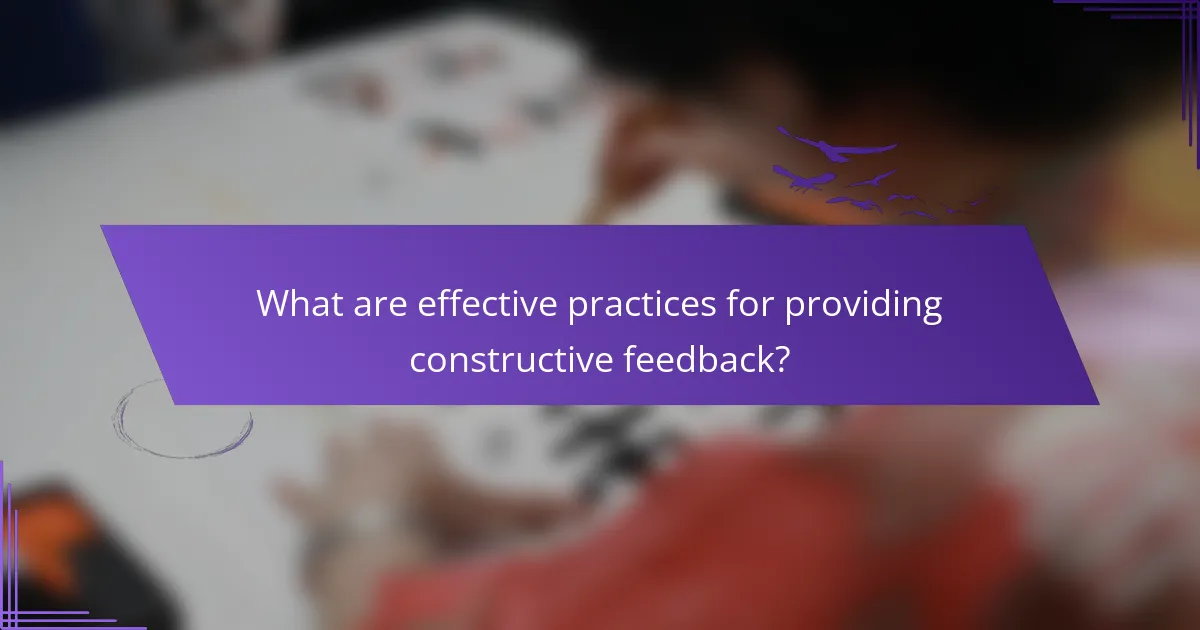
What are effective practices for providing constructive feedback?
Effective practices for providing constructive feedback include being specific, focusing on both strengths and areas for improvement, and fostering a growth mindset. These approaches not only enhance the quality of the feedback but also encourage a positive learning environment.
Use specific examples
Providing specific examples in feedback helps clarify your points and makes the feedback more actionable. Instead of saying “good job,” you might say, “Your analysis of the data was thorough, particularly in how you identified trends.” This approach gives the recipient clear guidance on what to continue doing.
When pointing out areas for improvement, use concrete instances to illustrate your suggestions. For example, instead of saying “you need to improve your writing,” you could say, “consider using shorter sentences in your report to enhance clarity.” Specificity helps recipients understand exactly what changes to make.
Focus on strengths and areas for improvement
Balancing feedback by highlighting both strengths and areas for improvement creates a more constructive dialogue. Acknowledging what someone does well boosts their confidence and encourages them to build on those strengths.
When discussing areas for improvement, frame them positively. For instance, instead of saying “this part is wrong,” you could say, “this section could be enhanced by adding more supporting evidence.” This approach promotes a more supportive atmosphere for growth.
Encourage a growth mindset
Encouraging a growth mindset means promoting the belief that abilities can be developed through dedication and hard work. When giving feedback, emphasize that mistakes are opportunities for learning rather than failures.
For example, you might say, “I see potential in your analysis, and with a bit more practice in data interpretation, you’ll become even more proficient.” This type of feedback inspires resilience and a willingness to improve.
Implement peer review rubrics
Using peer review rubrics provides a structured way to give and receive feedback. Rubrics outline specific criteria, making it easier for reviewers to assess work consistently and fairly.
When creating a rubric, include categories such as clarity, depth of analysis, and adherence to guidelines. This not only streamlines the feedback process but also helps recipients understand how to meet expectations.
Utilize feedback tools like Peergrade
Feedback tools like Peergrade facilitate the peer assessment process by allowing users to give and receive feedback in an organized manner. These platforms often include features for anonymity, which can encourage more honest and constructive critiques.
When using such tools, ensure that participants are trained on how to provide effective feedback. This training can include workshops or guidelines on best practices, ensuring that the feedback process is beneficial for everyone involved.

How does self-reflection contribute to learning outcomes?
Self-reflection enhances learning outcomes by allowing individuals to evaluate their understanding, identify areas for improvement, and reinforce their knowledge. This process encourages deeper engagement with the material and fosters a more personalized learning experience.
Promotes critical thinking
Self-reflection encourages individuals to analyze their thoughts and actions critically. By questioning their assumptions and evaluating the effectiveness of their strategies, learners develop a more nuanced understanding of the subject matter. This critical approach helps in making informed decisions and solving complex problems.
Encourages personal accountability
When learners engage in self-reflection, they take ownership of their learning journey. This accountability motivates them to set realistic goals and strive for improvement. By recognizing their strengths and weaknesses, individuals can create actionable plans to enhance their performance.
Enhances retention of knowledge
Self-reflection aids in the retention of knowledge by reinforcing learning through active engagement. When learners reflect on what they have studied, they create connections between new information and existing knowledge. Techniques such as summarizing key points or teaching concepts to others can further solidify understanding.
Supports goal setting
Setting specific, measurable goals is a crucial aspect of self-reflection. By assessing their current skills and knowledge, learners can establish clear objectives that guide their progress. Regularly revisiting these goals allows for adjustments based on ongoing self-assessment and changing circumstances.
Fosters lifelong learning habits
Self-reflection cultivates a mindset geared towards continuous improvement and lifelong learning. By regularly evaluating their experiences, individuals become more adaptable and open to new ideas. This habit not only enhances personal growth but also prepares learners for future challenges in various aspects of life.

What criteria should be considered for effective peer assessment?
Effective peer assessment relies on clear criteria that enhance collaboration, constructive feedback, and self-reflection among learners. Key considerations include clarity of assessment objectives, alignment with learning outcomes, and inclusivity of diverse learner needs.
Clarity of assessment objectives
Clear assessment objectives are essential for guiding peer evaluation. They should specify what is being assessed, the standards expected, and the methods of evaluation. For instance, if students are assessing a presentation, objectives might include clarity of content, engagement with the audience, and use of visual aids.
To ensure clarity, objectives should be communicated in simple language and shared with all participants before the assessment begins. This transparency helps reduce confusion and sets a common understanding among peers.
Alignment with learning outcomes
Peer assessment must align with the overall learning outcomes of the course or program. This means that the criteria used for assessment should directly reflect the skills and knowledge that learners are expected to acquire. For example, if a course emphasizes critical thinking, the assessment criteria should include elements that evaluate this skill.
Regularly reviewing and updating assessment criteria to ensure they match evolving learning outcomes is crucial. This alignment not only enhances the relevance of peer assessments but also reinforces the learning objectives for all participants.
Inclusivity of diverse learner needs
Inclusivity in peer assessment practices ensures that all learners, regardless of their backgrounds or abilities, can participate meaningfully. This involves considering different learning styles and providing various ways for students to engage with the assessment process. For example, offering options for written feedback, oral presentations, or visual projects can cater to diverse preferences.
Additionally, it’s important to create a supportive environment where all feedback is constructive and respectful. Establishing ground rules for peer interactions can help foster a culture of inclusivity and encourage learners to express their thoughts without fear of judgment.

Which tools facilitate peer assessment in online learning?
Several tools enhance peer assessment in online learning by enabling collaboration, constructive feedback, and self-reflection. These platforms streamline the process, making it easier for students to engage with one another and provide meaningful evaluations of their peers’ work.
Google Classroom
Google Classroom is a widely used platform that facilitates peer assessment by allowing students to share assignments and provide feedback directly within the system. Teachers can create assignments that require students to review each other’s work, fostering a collaborative learning environment.
To implement peer assessment in Google Classroom, teachers can set up assignments with specific guidelines on how to provide feedback. Students can use comment features to leave constructive critiques, which can help them develop critical thinking skills. It’s essential to establish clear rubrics to guide students in their evaluations.
One common pitfall is not providing enough structure for feedback, which can lead to vague or unhelpful comments. To avoid this, teachers should encourage students to focus on specific aspects of the work, such as clarity, argument strength, and adherence to guidelines. Regular check-ins can also enhance the quality of feedback provided.
